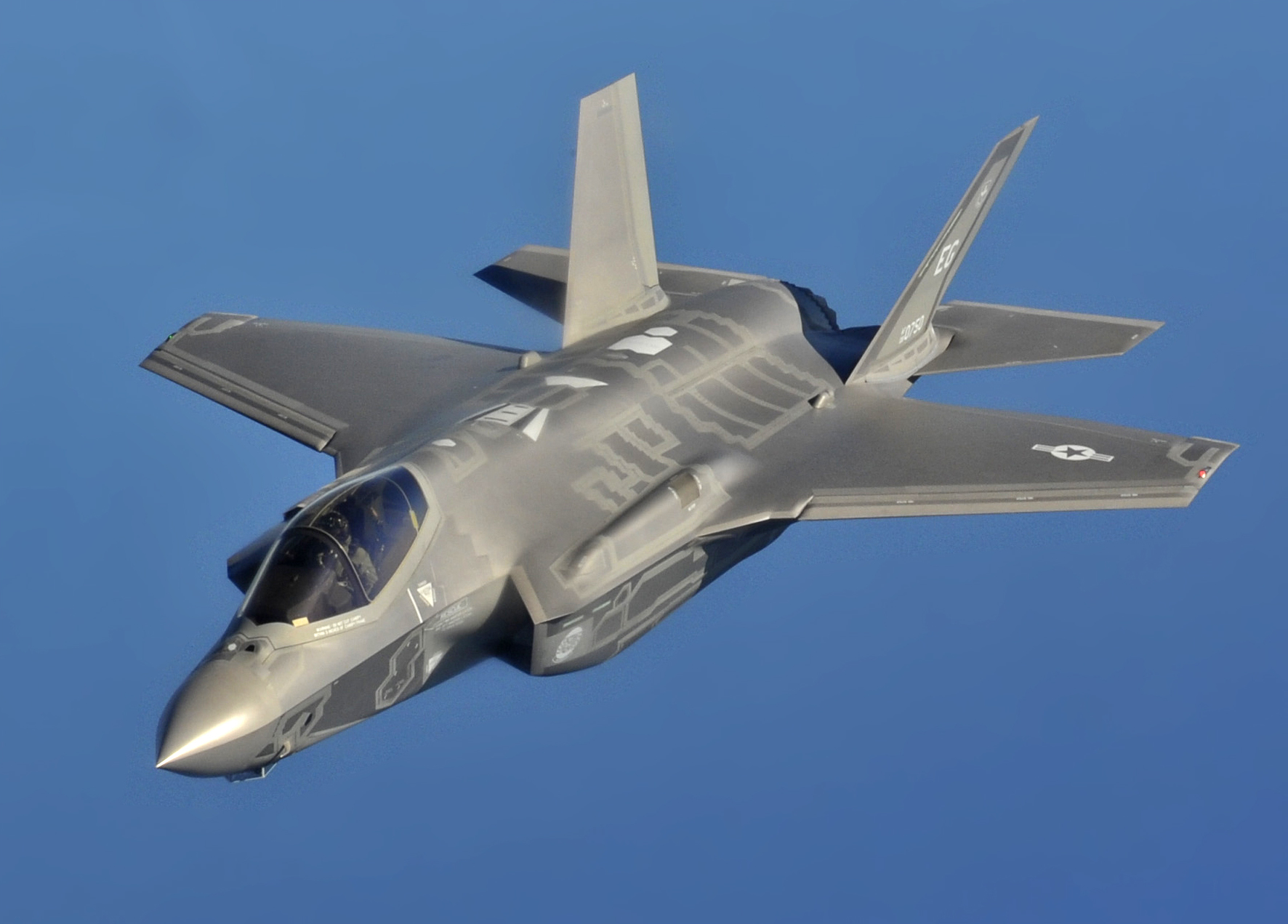by William J. Astore
How are you with numbers? I can deal with $1.5 million. I think I can even imagine $1.5 billion, a sum a thousand times greater. But how about a million times greater: $1.5 trillion? That happens to be the estimated cost of the Pentagon’s program to build, deploy, and maintain the no-longer-so-new F-35 jet fighter over its lifetime. How can any people invest so much in a technology whose fundamental purpose is dominance through destruction — and which reportedly doesn’t even work particularly well?
The Egyptians had pyramids. The Romans had roads, aqueducts, and coliseums. The medieval Europeans had castles and cathedrals. These days, America’s pyramids, aqueducts, and cathedrals are those warplanes, among other deadly weapons programs, including a $1.7 trillion one to “modernize” the U.S. nuclear arsenal. Unlike the massive projects of ancient history, which still endure and in some fashion represent the triumph of the human spirit, America’s massive spending on military weaponry has been for totems of power that will prove either ephemeral or make our very existence ephemeral, while casting a long shadow over our moment, thanks to the sheer extravagance and colossal waste they embody.
As ephemeral as the F-35 stealth fighter may prove in historical terms, it’s already a classic symbol of America’s ever more fruitless forever wars. Like them, the F-35 program has proven staggeringly expensive, incredibly wasteful, and impossible to stop, no matter the woeful results. It has come to symbolize the too-big-to-fail, too-sacrosanct-to-reject part of America’s militarized culture of technological violence.
Despite its astonishing cost and mediocre performance, the F-35 isn’t simply a product of the naked greed and power of the military-industrial-congressional complex. In a strange way, it also reflects the ongoing love affair Americans have had with weaponry of every sort. It’s about, you might say, the 1.5 trillion ways we worship warplanes and everything they mean to us.
Don’t think of “Jet noise, the sound of freedom” as merely a bumper sticker meant for the vehicles of Air Force veterans. After all, Americans invented the airplane and we still tend to see it as the means by which this country can dominate the global high ground, projecting our version of (super) power, while inflicting death across significant parts of the planet. It’s not so surprising, then, that our high-tech warplanes routinely roar in a celebratory fashion over American versions of those Roman coliseums, generating cheers and thrills among sports fans but little thought as to their cost, both in money and in lives.
Imagine, for example, what the $1.5 trillion to be spent on the F-35 over its lifetime might mean in green energy, or health care, or education, or infrastructure, or virtually any other pressing need in this country today. Given our actions, given what we’ve been most willing to extravagantly fund during this century, you’d think Americans truly believed a few squadrons of F-35s could blow up climate change or cure cancer or fix America’s roads and bridges. Then again, Donald Trump seems to think nuking hurricanes is a good idea! So why not?
A Brief History of the F-35 Program
I first heard of what would become the F-35 in 1995. I was then a captain in the Air Force, working on flight-planning software. I was told that a new Joint Strike Fighter, or JSF, was being developed. The “joint” meant that the Air Force, Navy, and Marines would all use it. Its big selling point at the time was the striking level of anticipated savings expected due to the commonality of the design, of spare parts, and of everything else. (Those in the know then, however, remembered the Pentagon’s previous shot at “jointness,” the TFX program in the 1960s; the resulting plane, the F-111, would be rejected by the Navy and unloved by the Air Force.)
The new JSF was advertised as offering the highest-tech possible at the lowest price imaginable, a fighter that would replace legacy aircraft like the Air Force’s F-16s and A-10s and the Navy’s F-18s. Winning the competition to develop the plane was weapons giant Lockheed Martin and a prototype F-35 Lightning II first took to the skies in 2006, by which time I was already retired from the Air Force. In the 13 years since then, the F-35 has gone through a mind-boggling series of major program delays and setbacks, burning money all the way.
In 2014, the plane’s woeful record finally caught the eye of CBS’s 60 Minutes, which documented how the program was seven years behind schedule and already $163 billion over budget. The Pentagon, however, simply plunged ahead. Its current plan: to buy more than 2,600 F-35s by 2037, with the assumption that their service lives will possibly extend to 2070. In Pentagon terms, think of it as a multi-generational warplane for America’s multi-generational wars.
Five years after that 60 Minutes exposé and 13 years after its first flight, the F-35 unsurprisingly remains mired in controversy. Harper’s Magazine’sAndrew Cockburn recently used it to illustrate what he termed “the Pentagon Syndrome,” the practice of expending enormous sums on weapons of marginal utility. The F-35, he noted, “first saw combat [in 2018], seventeen years after the program began. The Marines sent just six of them on their first deployment to the Middle East, and over several months only managed to fly, on average, one combat sortie per plane every three days. According to the Pentagon’s former chief testing official, had there been opposition, these ‘fighters’ could not have survived without protection from other planes.”
So far, in other words, the F-35 has had an abysmally low rate of availability. Technically speaking, it remains in “initial operational testing and evaluation,” during which, as defense journalist Dan Grazier has noted, it achieved a “fully mission capable rate” of just 11% in its combat testing phase. (The desired goal before going into full production is 80%, which is, in a sense, all you need to know about the “success” of that aircraft so many years later.) Compounding those dreadful percentages is another grim reality: the F-35’s design isn’t stable and its maintenance software has been a buggy nightmare, meaning the testers are, in a sense, trying to evaluate a moving and messy target.
These and similar problems led President Trump and former acting Defense Secretary Patrick Shanahan to push possible alternatives to the F-35 as a way of pressuring Lockheed Martin to improve its performance. In December 2016, before he even entered the Oval Office, for example, Trump tweeted about building F-18 Super Hornets in place of the F-35. Later, Shanahan advocated for an updated version of the venerable F-15 Eagle, made by Boeing, a company for which he had only recently been a senior executive. But the president’s tweets have moved on, as has Shanahan, and Lockheed Martin continues to hold all the cards. For the Pentagon, it’s still the F-35 or bust.
Unsurprisingly, the president has changed his tune, enthusing that the F-35 is invisible (“You literally can’t see it”) rather than merely difficult to detect on radar. (He has also referred to Marillyn Hewson, the CEO of Lockheed Martin, as Marillyn Lockheed.) The main selling point of the F-35 is indeed its stealth technology, marking it as a “fifth generation” fighter when compared to the older F-15s, F-16s, F-18s, and A-10s, which are decidedly unstealthy and radar detectable. Primarily because of such technology, the Pentagon argues that the F-35 will prove far more “survivable” than previous warplanes in any future conflict with Russia, China, or some other country equipped with sophisticated radars and surface-to-air missiles.
Yet such stealthiness comes at a real cost and not just in monetary terms. To maintain its stealthy profile, the F-35 must carry its weaponry internally, limiting its load and destructive power compared to “fourth generation” planes like the A-10 and F-15. It must also rely on an internal fuel system, which will limit its range in battle, while its agility in air-to-air combat seems poor compared to older fighters like the F-16. (The Pentagon counters, unconvincingly, that the F-35 wasn’t designed for such dogfighting.)
As a former Air Force project engineer and historian of technology and warfare, here’s my take on the F-35 program today: in trying to build an aircraft to meet the diverse requirements of three services, Lockheed Martin has produced a jack-of-all-trades, master-of-none albatross. Each military service piled requirements onto the F-35, as ever more esoteric features were added, including that stealth capability; special software featuring eight million lines of code; unique (and wildly expensive) helmets for its pilots; and vertical landing/short takeoff capacity for the Marines, which led to an airframe design that made it ever less maneuverable for the Air Force and Navy. The result: perhaps the classic example of a plane that is far less than the sum of its staggeringly expensive parts.
To get more specific, consider the mission of close air support, or CAS, which means supporting troops in or near combat. The best and most survivable plane for such a role remains the one specifically designed for it: the unglamorous A-10 Warthog, which ground troops love but Air Force officialdom hates (because it was designed in response to Army, not Air Force, needs). By comparison, the F-35, which is supposed to fill the A-10’s role, simply isn’t designed for such a mission. It’s too fast, meaning its loiter time over targets is severely limited; its weapons load is inadequate; it has only one engine, making it more vulnerable to ground fire; and its (malfunctioning) gun lacks punch. (It also costs twice as much to fly.) Despite all this, the Air Force continues to advocate for the F-35 in a CAS role, even as it grudgingly re-wings A-10s to extend their lives.
And keep in mind as well that, if you want an attack platform that can loiter for hours, while removing all risk to pilots, why not just use already existing drones like the military’s Reapers? Who even needs an expensive F-35 stealth fighter? To these and similar criticisms the Pentagon responds that it’s fifth generation! It’s new! It’s stealthy! It’s a game-changer! It scares the Russians and Chinese! And if those answers don’t work, there’s always that old standby: tell me why you hate our troops!
Meanwhile, Lockheed Martin’s profits are soaring as that company and the Pentagon sell the F-35 to allies around the world. Despite its delays, cost overruns, and performance issues, it’s still being promoted as America’s latest and greatest. Foreign military sales have the added benefit of driving down per-unit costs for the Pentagon, even as politicians tout the F-35 as a huge job creator. In short, with no alternative in sight, Lockheed Martin remains top gun in the Pentagon’s cockpit (Eat your heart out, Tom Cruise!), with virtually guaranteed profits for the next half-century.
Touching the Third Rail of American Politics
Refusing to genuflect to “the troops” — that is, the U.S. military — has become the true third rail of American politics. In practice, this has meant giving the Pentagon a blank check to spend trillions of dollars on whatever it wants, including a fighter jet with a distinctly dubious record, once promised to the Pentagon at $38 million a plane but now estimated to cost $158.4 million each. If being a decade behind schedule and $200 billion over budget only wins you more money and more leeway, what does a military contractor like Lockheed Martin have to worry about? Even an outspoken progressive politician like Senator Bernie Sanders has muted his criticism of the F-35 (since some of them are to be based in his home state of Vermont, offering the promise of future jobs).
I’m old enough to remember Senator William Proxmire and his “Golden Fleece” awards. Nearly half a century ago, in what now seems like an alternate American universe, he had the temerity to regularly criticize major defense contractors when they fleeced Americans out of billions of dollars for wasteful weaponry. Today, that sort of principled outspokenness is rare indeed in the halls of Congress and rarer still in the White House. With both Congress and the president lining up to sell F-35s, what are ordinary Americans to do?
After all these decades of growth, the military-industrial-congressional complex is strong indeed. It’s not, however, omnipotent — not yet anyway. Its Achilles’ heel is funding. If Americans were, Proxmire-style, to start holding the weapons makers and the Pentagon accountable for their messes and mayhem in a language they understood — money — change might be possible. If, however, we continue to equate such deadly and staggeringly costly weaponry with safety and security, if that money continues to flow prodigiously to the Pentagon, the weapons makers, and their camp followers, you can count on two things: America’s forever wars will keep on churning and F-35s will soon roar loudly over a stadium near you.
One of these days, look for those same planes to be soaring in the skies over various unfortunate countries, dropping “Made in America” calling cards on their people. Just don’t look for them striking at cancer or climate change or solving any of the actual problems we face on this planet.
A retired lieutenant colonel (USAF), former project engineer, and historian of science, technology, and warfare, William Astore is a TomDispatch regular. His personal blog is Bracing Views. Republished, with permission, from TomDispatch.






The religion of Militarism has no place for ‘WHY’ either inside or outside. In a time that we need to heal everything, the specialists of destruction keep the lead. It is like we are still in the stone age.
‘America First’, would certainly sound ‘ominous’ to the very American military weaponry scientists, politicians and their advocates who take pride in being American: if only they pause for a moment to view the unbelievable statistical data on the reality of the American People: From the shocking number of the Americans living in appalling poverty to the number of Americans on drugs, or suffering from deep depression and clinical depression, to the gun crimes and other crime rates, suicide, self-harm, PTSD, sexual attacks, violent rapes, family breakups, prostitution, the corruption within the church and the governmental agencies, the two century old racism and cultural poverty, and the number of prisoners, then maybe they will realise that their ‘land of the brave and home of the free’ is a ferocious unhappy tiger rotting from inside, dying but preoccupied with attacking others he is unaware of his own ruin, because to prove he is the most ruthless predator to be reckoned with is all that matters to him.
In that sense America is First: decomposing from inside while roaring to dominate the jungle that will eventually bury him in its wreckage.
With millions in U.S. warplanes tens of thousands civilians killed: Dresden.
With billions in U.S. warplanes hundreds of thousands civilians killed: Vietnam (2 millions), Afghanistan, Iraq.
With trillions in U.S. warplanes millions of civilians wiped from the face of the Earth.
What a great article. An honest appraisal.